Enjoy DatePsychology? Consider subscribing at Patreon to support the project.
I have written previously on sexual behavior in 2021 and how many people had sex in 2021, based on the General Social Survey. We have seen a slow climb upward where fewer young people, men and women both, are having sex.
In 2021 15% of all men did not have sex in 2021, while 22% of all women did not have sex. The numbers were much higher for the youngest demographic (18-25); 42% of young women did not have sex while 23% of young men did not have sex.
I also looked briefly at sex within relationships. Depending on the demographic, only between 5% and 15% of sex occured outside of relationships. Sexual activity is closely linked with current relationship status. Most sex occurs in relationships and the people having sex the most frequently are men and women in relationships.
What I didn’t look much at was relationship status. It’s possible that the pandemic, as well as the general trend toward having less sex, is also reflected in relationship status.
I will focus mainly on three variables from the 2021 GSS: age, sex and the “Posslqy” variable which measures having a “steady partner.”
The Posslqy variable and what it measures
To avoid ambiguity on what the Posslqy variable measured in the GSS, here is the question that was asked and the four potential responses:
Which of these statements applies to you?
- I am married and living in the same household as my husband or wife
- I have a steady partner, and we live in the same household
- I have a husband or wife or steady partner, but we don’t live in the same household
- I don’t have a steady partner
This is a bi-annual variable that the GSS began collecting in 2012. This means we have data for the years 2012, 2014, 2016, 2018 and 2021. This gives us a ten year window to observe a trend, multiple replications over that time and a period before the COVID-19 pandemic.
In this article I use the term “single” to refer to people who responded “I don’t have a steady partner.”
What Posslqy does not measure
This variable can tell us who is married, both married and cohabiting and who is in a steady partnership. As such, it is a good variable for serious relationships. However, by being conservative in its measurement of “steady” partnerships it will also be an underestimate of total relationships.
Many people are in sexual and romantic relationships they would not list as “serious.” Friends-with-benefits (FWBs), “situationships” and casual daters all fall into this category.
The relationship is also a snapshot, so it will underestimate relationships over time. For example, it will exclude people who are recently broken up as well as people who will enter into relationships in the near future.
This means we can’t assume that anyone who responded as being single has been perpetually single, romantically uninvolved or sexually inactive. It will be an underestimate of romantic involvement, but we can’t know by how much.
Relationship stability, 2012-2021
Here is a table of the raw data:

If you have read my article on how to know if your sample size is sufficient, you will recall that around 1000 people is the gold standard for nationally representative surveys. At this sample size we can generalize to the entire US population with a margin of error of around 2%.
If you look at the bottom row, you will see that the percentage of singles in the US has remained highly stable pre and post pandemic. For the last ten years, American singledom has hovered around 30%.
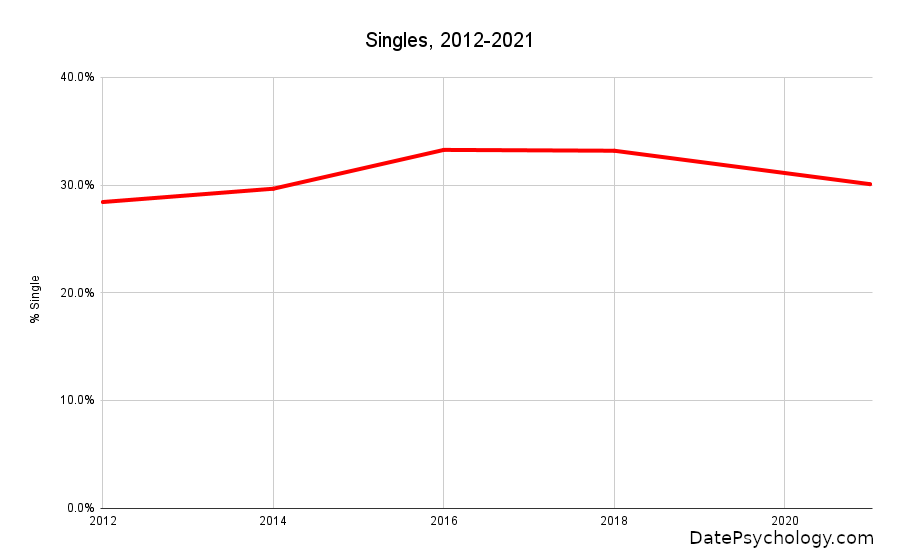
Corroborating the GSS data
As a large, random sample with high compliance the GSS is as close to a truly representative sample as we get in data collection.
However, it’s always good to corroborate. We can check other nationally representative samples and compare them with the GSS dataset. A lot of research does not use random nationally representative samples, but rather convenience samples. We will typically find random representative samples conducted by polling firms, or by the US Census.
The Pew Research Center conducted a large, nationally representative survey of single Americans in 2019. Here are their results:
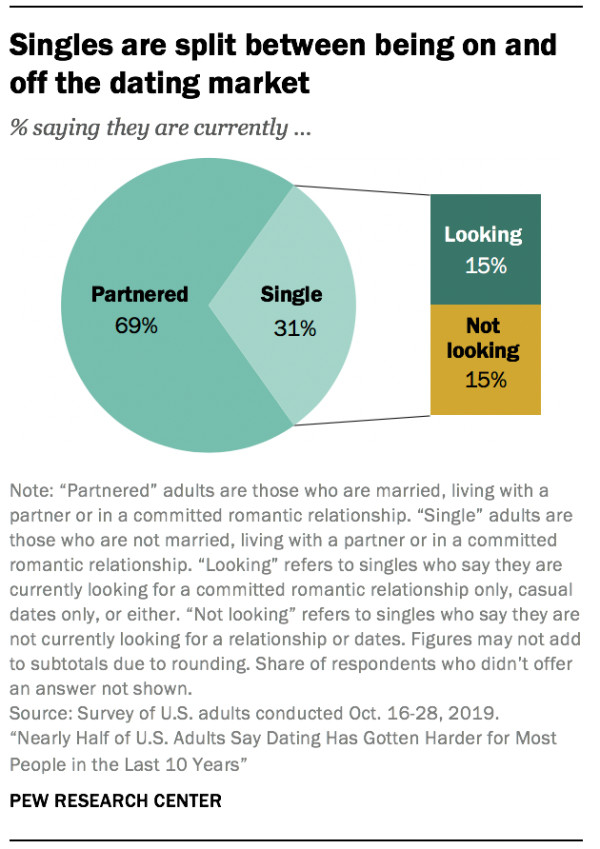
The Pew report tells us that 31% of Americans were single, which is consistent with the data for 2014-2021.
A second source we can look to is the US Census Bureau. The US census does not give us a measurement of singlehood, instead limiting itself to married and cohabiting couples. This will underestimate the number of people in relationships (clearly not all people in relationships are married or living together), but it will give us a figure to adjust upward from.
According to the US Census Bureau, in 2021 58.4% of adults were living with a spouse or unmarried partner. We therefore can expect the total number of relationships to be above 58.4%.
In the GSS 2021 data, 50% of adults were living with a spouse and 13% were living with a steady partner. We only see a 5% deviation across the US census and the GSS.
GSS breakdown by age
Here are the figures for 2012-2021:

Singlehood has increased for the age group 34-41 by 8%. Meanwhile, singlehood has also decreased for the 18-25 age group by 17%. There is only a 1% total difference between 2012 and 2021 in total singles for age groups combined.
2021
Relationships are not randomly distributed. Knowing the total number of Americans in relationships is not the entire picture. Age is one of the variables that we should look at. The GSS collected data up to 88 years of age. Below I have divided GSS age data into three groups, stopping at age 41.
Within the 18-25 age group, 43% are single. For 26-33, 37.4% are single. In the 34-41 age group 22.9% are single. In total, between ages 18-41, 34.5% are single.
The younger someone is the less likely they are to be in a relationship. Only in the 30+ range do we begin to see more people in relationships than the national average, at 77% versus 70%.
2018
In the 18-25 age group, 52.6% were single. For 26-33, 36.2% were single. 34-41 gives us 21.1% single. In total, 34% single.
In 2018, before the COVID-19 pandemic, more of the youngest age group were single than they are now. Age groups 26-33 remained quite stable at 37.4% and 36.2%, as did ages 34-41 at 22.9% and 21.1%.
Youth still predicted a lower likelihood of being in a relationship before the COVID-19 pandemic. The national relationship average is still weighted by the oldest demographics. However, we see an 8% reduction in singlehood comparing 2018 with 2021. The youth are in more serious relationships now than they were before the pandemic.
2012
18-25, 60.8% single. 26-33, 32.8% single. 34-41, 14.8% single. The total, 33.6% single.
In 2012 we saw even more singles than in the recent year. 17% more of the 18-25 age group were single in 2012.
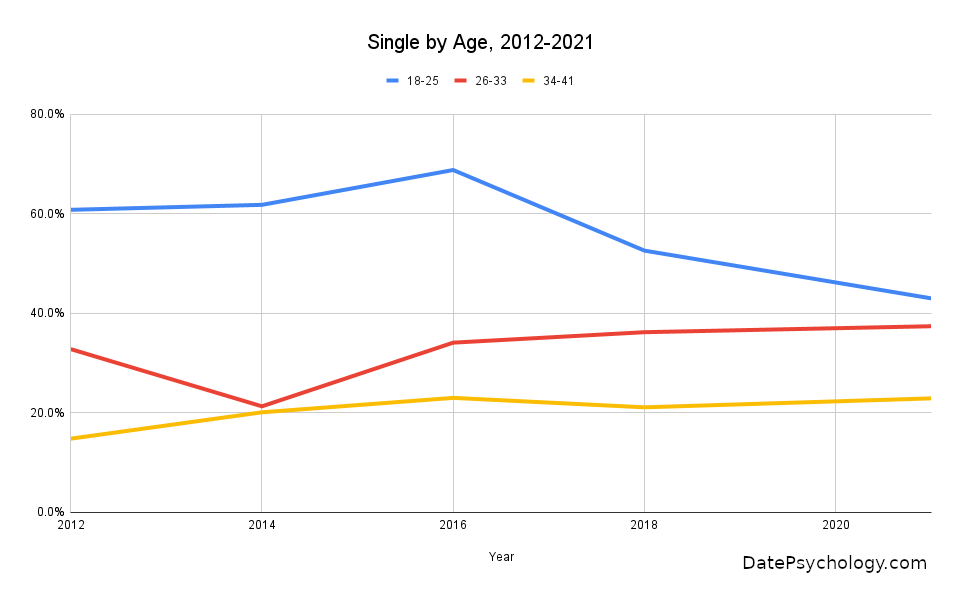
Keeping in mind that the national average for singlehood was 30%, by 34-41 people should be less likely to be single on average. This group did not go higher than 23% and was only at 14.8% single at its lowest. This has consistently been peak relationship time, when adults are most likely to be in a relationship before age 40.
Meanwhile the youngest age group has consistently remained the most likely to be single. We see a majority of young adults between 18-25 reporting singleness annually up until the past year.
We don’t see the largest changes between 2018 and 2021, or before and after the COVID-19 pandemic and associated lockdowns. The largest change was fewer singles in the 18-25 age group, down from 52.6% to 43%.
GSS, sex and relationship status
As we’re looking at a predominately heterosexual sample, we should expect the sex ratio for relationships to be close to 1:1. For every man in a relationship there is a corresponding woman. Very few people report being in poly- relationships of any kind.
However, we see that women are consistently more likely to report not having a steady partner up until 2021.

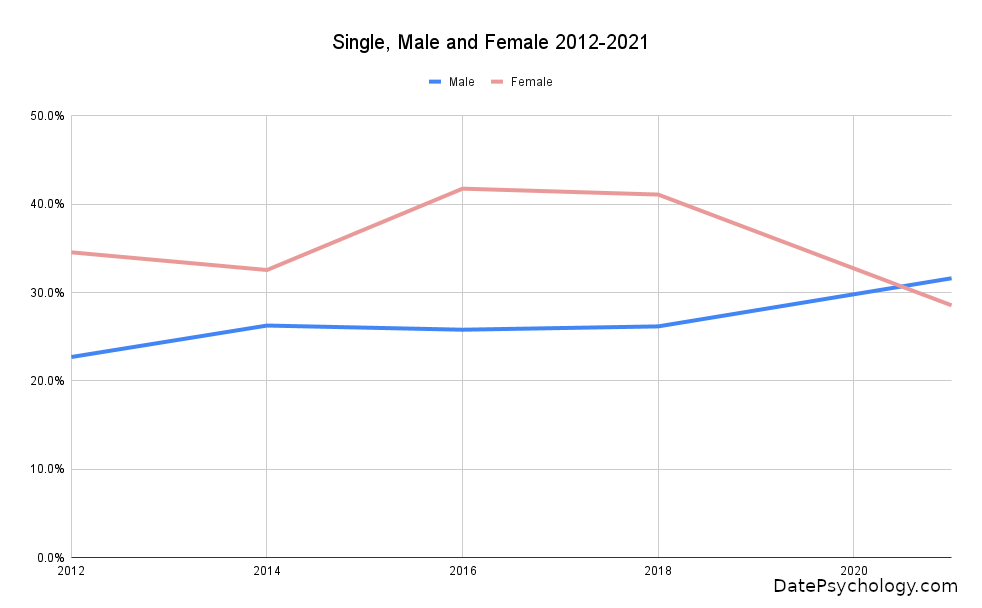
GSS 2021, relationship status by sex and age
This is likely driven by age effects. Let’s look at 2021, by age and sex:

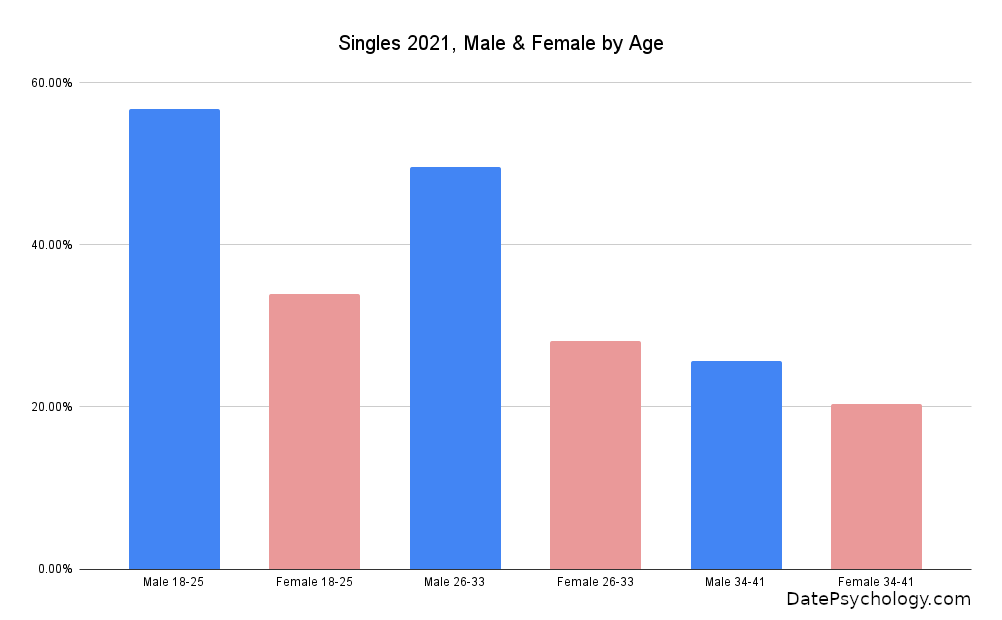
Here we see that men are consistently more likely to report being single. However, the gap closes as men get older. We can corroborate the GSS data with the data from the Pew 2019 survey as well:
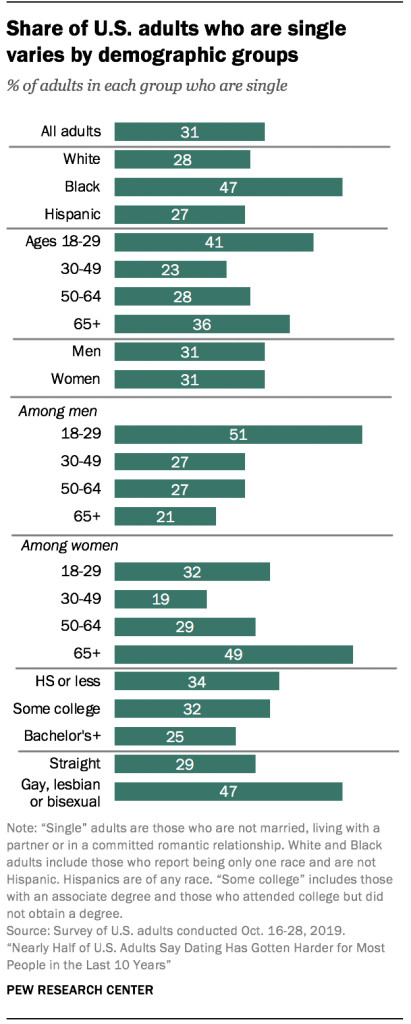
There are likely two things happening here. First, men die earlier. This leaves more single women in the highest age bracket. Second, women date up in age-gap relationships. We usually end up with a close 1:1 ratio across the entire population, but the rate of singlehood is not evenly distributed.
That most men and women will not remain single in their 30s and up is also explained by the increasingly late age of marriage. According to the recent US census, the average age of marriage for men is 30 and for women is 28.
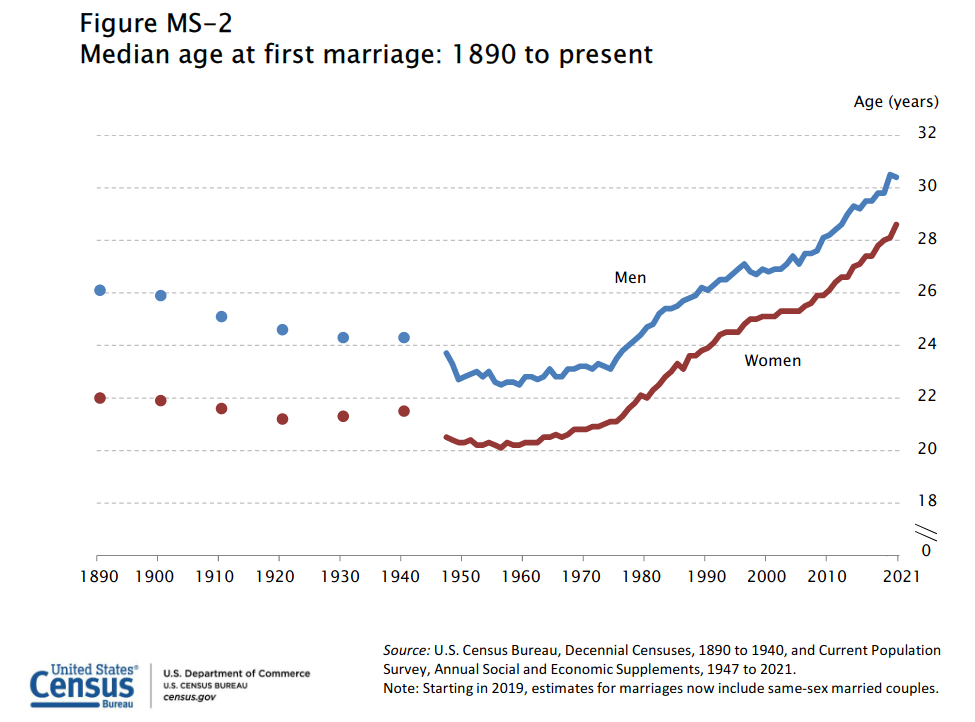
We can see this in the GSS data as well, by looking at the percentage of men and women who reported being in a steady partnership and/or married, but not living together:


By age 26, the gap between men and women for non cohabiting or unmarried relationships closes. We see less disparity in men and women from 26 onward who report cohabiting in a steady relationship:

GSS 2012, relationship status by sex and age
Let’s compare 2021 with 2012 for age and sex:

In 2012, both young men and women aged 18-25 were more likely to be single. However, women were almost twice as likely to report being single in 2012 as in 2021 (33% vs 62%). Young men in this age bracket only differed by 3%, with more being single in 2012.
Men and women were also less likely to report being single in the 26-33 age group, by 6% and 8% respectively.
At 34-41, men were less likely to report being single at 10% versus 25%. Women remained fairly stable at 20% vs 21%.
Conclusion
The overall total of singles has remained very stable. However, we see some variation across age and sex demographics within that stable trend. The youngest men and women are the most likely to be single. Young men in particular are more likely to be single than young women and young men constitute the largest single demographic.
Singledom for young men in the 18-25 and 26-33 age groups has remained fairly stable over the last ten years. Singledom for women between 18-25 has halved, while singledom for men 34-41 has more than doubled.
Why have young men consistently been more likely to be single? I would caution against looking for a single cause. This trend predates COVID-19 and it predates the rise of dating apps. Young men are less likely to want to commit, so choice may be part of the picture. Young men are also more likely to have low incomes, low education and to live at home. This makes young men less desirable mates. At the youngest range of 18-25, young men may even be less physically imposing or less masculine, making them less physically desirable. The data cannot tell you why, so you are welcome to speculate. Please share your ideas and let me know what you think may be the cause in the comments.
Summary
- Singledom has remained very stable from 2012 onward and despite the pandemic.
- The highest rate of single men is in the youngest cohort of men, aged 18-25; the highest rate of single women is in the oldest cohort of women.
- Young singlehood may be explained by age-gap relationships, later age of marriage and earlier mortality for men.
- Singlehood for men aged 18-25 has remained stable since 2012, but is almost twice as low for women in 2021.
- Nationally representative samples across the GSS, Pew Research and the US Census Bureau give us very similar numbers both for 2021 and previous years. This replication is a strong indicator of the reliability of the datasets.
4 comments
This could be due to computer games and the internet increasing social isolation and blunting men’s social skills. Girls generally don’t spend as much time online as boys. Additionally, men often don’t have fathers or other male relatives in their surroundings, which leads to a lack of masculine character development and a deficiency in the confidence necessary for mating effort. Menelaos Apostolou’s research suggests that poor flirting skills and low mating effort are the main predictors of involuntary bachelorhood, which supports my opinion.
I’ll share a 2 personal accounts seeing the current trend of relationships. Because tbh unfortunately things are being excessively generalised & women like me are, for the lack of a better work, hardly speaking our side because of the lack of time.
I had my 2nd relationship halfway down 2nd year of med school at 20 years of age. The 1st was a long distance one back in high school (just 3 IRL moments with no physical stuff involved). Stayed laser focussed after that throughout high school. Funded my own education through scholarships in high school, then entire med school education paid by the govt. since I cracked the competitive exams. Then OBGYN residency.
The 2nd one was with someone I’d been really good friends with for 1.5 years. Literally the same classes/projects/ward rounds/labs(anatomy, physio, path, biochem, micro all throughout 1st & 2nd year). Back then my relationship with dad was horrible (deeply entrenched patriarchy). I’d say I had a “Rocky movie” moment back in 10th grade when he’d tried to hit my mom & I got in between (never thought once). All I remember is the numbing pain & getting back up each time. I’d allowed myself to be vulnerable about this with my “”friend”” who later became partner then ex.
On what basis had I agreed to get into a relationship?-
1. A very good friend for 1.5 years. Someone I had been vulnerable with.
2. Gone through the same struggles whilst helping out a common friend (or at least I thought I had).
3. Common goals- same course, participating in the academic activities, working on the same research projects & medical device initiative etc.
4. Seen(and helped) him work his way out of a toxic med school frat boys hostel environment where they grew marijuana on the roof.
5. Exact Polar opposite of my violent father.
6. I had some anger issues & somehow he always felt like a calming effect.
7. Thought he was “genteel” (yeah, no typos there)
I’d been asked out by another guy in my batch who was way taller, way more good looking than ex just 1 month ago. I’d say this was a “Chad”. Had masculine features but a gentle nature as well. Played football for the med school team, great in studies, a good acquaintance (same group of friends), even the same cultural background. And I refused. Somehow at the back of my mind I knew I had a tiny crush on “”friend”” of 1.5 years.
“”friend”” was also good looking. but the above 7 things mattered more. No “”mating down”” thoughts for “”mate retention”” here. Just plain cerebral connections. Or so I thought.
2 weeks into the relationship & I had this huge war with my dad. I needed emotional support. Went to his house. Big mistake. When the kiss began turning to something more I pushed him away, said no but he kept going. No force. Just that covert coercive. I’d cleared my stance on the physical aspects 2 weeks ago when I’d gotten to know that he used to exchange nudes with his ex. And the fact that I was starting this relationship for the long term (will leave it to your imagination, call me naive for looking for a lifetime commitment- because I was).
Didn’t know the physical thing would come so quick. I gave in thinking that this was guy was forever. Just foreplay & him jacking off etc. That’s what continued for the rest of the relationship. No vaginal or anal penetration (I was later diagnosed with Stage 4 Endometriosis. No wonder it hurt like hell when he tried even a nanometer). I wish I’d known Dr. David Buss’ work back then on evolutionary psychology. Because ex came up with weird reasons for his libido. Quickly turned into a nightmare…..
1. Began controlling my father’s narrative & my anger issues against me.
2. Screaming at me over the call for me, leaving with my friends from med school for a friend’s aunt’s wedding when it was pre-decided he was going alone from his place. Then completely changing expressions to happy at the mere sight of me at the event.
3. One moment he’d cook for me, the other he’d be like “didn’t you want equality? clean up the dining table now!” when I’d be on the 2nd day of my period- Undiagnosed Endometriosis. He’d had a disc prolapse before the relationship began. just a week ago before this periods pain incident of mine he’d gone like “If I get paralysed, will you leave me?” I’d been supportive about all his health issues.
4. Continuous attempts at heavily patriarchal grooming- “respect my parents” “my parents have always made special arrangement for me” & negotiating with equality, “society” “society”, attacks on my culture & background (which has a very rich history btw & I’m super proud of it). I constantly resisted. And he manipulated it as “”hardcore anger issues””
5. His long lost relative needing blood. He had sick sinus syndrome. I understood & volunteered to donate. my mum didn’t want me to. Made up an excuse about ex fainting because of his syndrome so I had to donate. Ex gets to know & screams at me. Suddenly the excuse that was made for him seemed to tarnish his image. Long lost relatives, blood relations nothing mattered. Just. The. Image. Period.
6. We’d be working & he’d want the physical. We were travelling for a medical conference & he wanted it while travelling. We’d be in the library & he’d want it there. The simple things in a relationship began feeling like a trade off.
Want to watch a movie & cuddle together? – jack off
Want to study/work together?- it’ll end in …..
Literally wanted me to enact the voices from porn, wanted a deep throat head (my gag reflex was all on red alert) – literally had to look up porn because I had no clue sh** what tf he was talking.
And then he’d complain “why don’t you initiate?”
7. He’d continuously go “oh women take away family properties” “alimony” etc back in 2016. To whom? A woman who was way way better off in family financials & status than his side. But not for once have I ever or will ever l think my parents’ money as mine. Or I wouldn’t have reached this far with zero debt & plenty savings of my own.
8. Countless dark trio incidents. Countless broken boundaries (didn’t even know back then they existed). Despite the Undiagnosed Endometriosis, I tried. Even tried to bring in some safe experimentation. I’m not comfortable with porn (blame it on ethics or feminism I care not, It’s wrong & fake). I’d rather get the descriptions from good romance novels- cerebrally challenging & leaves it to your own imagination. But again, half way trade off for jack off. My normal leukorrhea ended with an “ewww” from him. While I was ok with his hypertrichosis & his teeny tiny anal fistula. Never shamed him because THESE were “”NATURAL”” he could not control.
And then I got a disc prolapse. Went home to recover. Guess what happened?
1. He became an aggressive advocate for his se**al desires.
2. Began pestering me for nudes. When I had a hard time even getting out of the lumbar puncture position.
3. The manipulation was so ridiculous that he’d literally go from “I’m having suicidal tendencies” to “my sexual desires need to be fulfilled”
4. The entitlement, lack of regard for someone else’s health conditions & respect; was flabbergasting.
5. My Follicular cyst held more importance than the horrible sciatica. This coming from a person who apparently had his own disc prolapse episode.
Throughout he kept feeding me rationalisations like “men’s libido” “it’s natural” “not something that men can control” “shouldn’t be controlled” countless excuses.
A 20 year old fellow med student. A 20 year old fellow med student with deep dark trio tendencies. A 20 year old boy whose was so immature, but pretended to so mature.
I broke up in 11 months. It put the rest 3.5 years of med school into a whirlwind. I knew But I guess nothing can replace the need for mental peace. Lost all my friends in the process, only to find myself. Had flying male monkeys try to shift the work on me during internship & COVID. Stood up to it all. For the 1st year post break up with lumbar corset. And subsequently by building myself back up by living the best years of my college life. Organising events, fests, research projects, joining NGOs, approaching the most strict professor who inspired me to be a Surgeon.
Glad that I lost my virginity(dictionary defn) to an endoscope during my 5 hour laparoscopy for Stage 4 Endometriosis when they had to check for Adenomyosis. With written consent. To a 70+ male OBGYN who was the only OBGYN who didn’t say “get pregnant for the endometriosis to go” to a 23 year old. Joys of small things (making big impacts).
Fast forward to 2022 from 2017, during my ENT residency I met this guy from the Ortho dept. (nothing hypermasculine, way less “”SVM”” than any of the above), just a humorous n honest personality. Or too humourous.
??Relationship_3??
Well turns out he wanted it “”casual””. wanted the “nudes”. Within 3 days. With the trade offs. That’s 72 hours for you. My mind was all muddy with my gran dying (closest person to me) whilst I contemplated leaving a residency I didn’t want to do but had settled for. Him jacking off on a simple video call while I was studying was & telling him about how I needed to change residencies was the end.
I wrote an 8 page closure letter, walked away from him & the residency. To prep again.
Then he calls after the results 2 months later. I don’t pick.
I get the residency that I want. Get a message saying “let me know your results,”
Success or failure, he has the right to know nothing because he is “nothing” anymore.
I already had a Phd in no-contact from 6 years back.
A month later again another call.
I unblock & ask if the closure wasn’t enough. He goes “sorry” & we’re done.
No 3rd Relationship. Might I add his ex cheated on him? And maybe I nearly became a rebound. But then again projections projections. On me. Wasn’t having it.
These men are the same 20s range. They’re still in the 20s. And no wonder everywhere in Youtube it’s all about “”how they’re not getting s**””. The issue has become different goals. There’s a complete expectations mismatch. More so, there’s a mismatch of men seeing every woman from their lens of libido/short-term gains/fun/s**/evolutionary psychology. And justifying & giving excuses by rationalising evolutionary psychology as something that is so uncontrollable that… well sigh.
Just an eg. no hate against any religion- When the shortcomings of Hinduism was pointed out, Hindus pulled up their socks & tried to bring about a reformation with abolishing Sati, child marriage etc. When the same happened with Christianity or Islam you had better forms like Sufism etc come out. Nobody like apologetics.
Manosphere behaves like apologetics.
I come from a state in India where women’s liberation is just taking roots. In a majorly rural state freedom is not handed out to women on a silver platter. There was a time when I complained about reservations in India. Equality felt like oppression. Then I began looking at my societal privileges as a so called upper caste Hindu (not financial, just societal where I’m not ostracised as the Dalits are). Worked my a** off & clawed my way out.
There’s a new kinda stupid argument that’s being made by some trolls from India. Which usually goes with “OH so Pakistan do….” Talk about lowering standards whilst being apologetic & blind to the ills in the background of unnecessary hyper-nationalism where no criticism is allowed.
There are countless role models out there. You have role models like Dr. Viktor Frankl, David Goggins, Jocko from whom even women take inspiration. And complain about no role models.
On one side there’s the overturning of Roe v Wade, men complaining about “not getting sex” & “not having long-term partners” & “loneliness epidemic” & “women are sluts & bitches & body count” & “vasectomy effects my manhood” all in the same line. And then women are called “confusing”. Its men don’t know what they want. Or maybe they do but still want it all.
Let me break it to you. In general circumstances, You can’t have it all. A lot of women have learned to accept it & move on. Men are still busy typing coffee cup emojis & cat calling even in the comments.
There will always be sacrifices to make. But you’ll have your choice. And you prioritise as per what you truly want. Instead of having FOMO.
Every myth that Alex debunks stems from conformational bias,the roots lie in deep insecurity.
Feminists (going with it’s true core unmuddied defn) – Women are willing to have conversations but it takes two to have a dialogue. And dialogue doesn’t comes from immature defence mechanisms, excuses, victimhood & blaming. Every human being has some or the other leverage. Some flimsy bit of privilege they could use it to their advantage.
For large majority of women, Life’s not all about sex. Sorry to burst the bubble. And instead of the whole “intra sex competition” give a hand of empathy to your fellow men & brothers. As women have been doing it for our fellow women & sisters. Manosphere tries to poison the latter but they couldn’t be more wrong. You can bash women all you want & continue to play the blame game. But until an empathetic, non-judgemental, honest, without-the-need-to-feel-superior/inferior & transparent dialogue does not happen amongst men about real issues of men; women/feminists(who’re blamed so much) can only do so much.
If someone failed an exam because they didn’t study despite the opportunities. No matter the excuses, the reason why you failed would be that “you didn’t study,”. Most times you make opportunities too.
And nope. No self-respecting woman will go back to those ultra age old fantasies being propagated. If you change your perspective a bit, women progressing is a challenge for men to progress too. “”Challenges”” per say are supposed to be masculine right? Snake oils who claim to help men whine more about women.
Stop looking in the wrong places for your momentary needs. And if you need the latter so badly, make peace & compromise with the people who’ll give it to you. There’s so many men issues that need attention & they’re just being brushed under the carpet AGAIN in the name of toxic masculinity, women bashing etc.
It starts with men themselves making an effort to listen & not crackle & say “p$$Y” when your fellow man tried to speak up about something. Because women have tried. But it takes two to tango.
Thank you Alex. I’m glad I stumbled upon you. You’ve refreshed some of my biostats too along the way. Good start to research methodology for residency.
> Literally wanted me to enact the voices from porn, wanted a deep throat head (my gag reflex was all on red alert) – literally had to look up porn because I had no clue sh** what tf he was talking.
And then he’d complain “why don’t you initiate?”
Typical mind fallacy. Or maybe untypical. https://aella.substack.com/p/women-prefer-more-violent-porn-and
> I often hear people saying that porn is full of depictions of smeared-mascara, aggressive blowjob stuff that appeals to men and trains them to treat women horribly. Women prefer gentle stuff – porn marketed towards women often focuses on soft light, good depth of field, gentle kissing and candles.
> So – is this true? How do men and women’s preferences around violence in porn and sex differ?
> Are men more interested in sexually violent content than women? According to my data, absolutely not.
> I looked at reports of watching violent porn, arousal from nonconsent, brutality, bondage, sadomasochism, gentle/cruel power dynamics, and humiliation. Across the board women report more interest in these things than men, and report greater interest in submission than men report being dominant. The sole exception was ‘brutality’ – an rare fetish with slightly more male than female preference. Trans people had greater interest in sexually violent content than cis people in general, but especially trans men.
> I find this all a bit ironic; when pornographic websites ban violent or nonconsent categories, they’re disproportionately reducing women’s access to preferred porn.